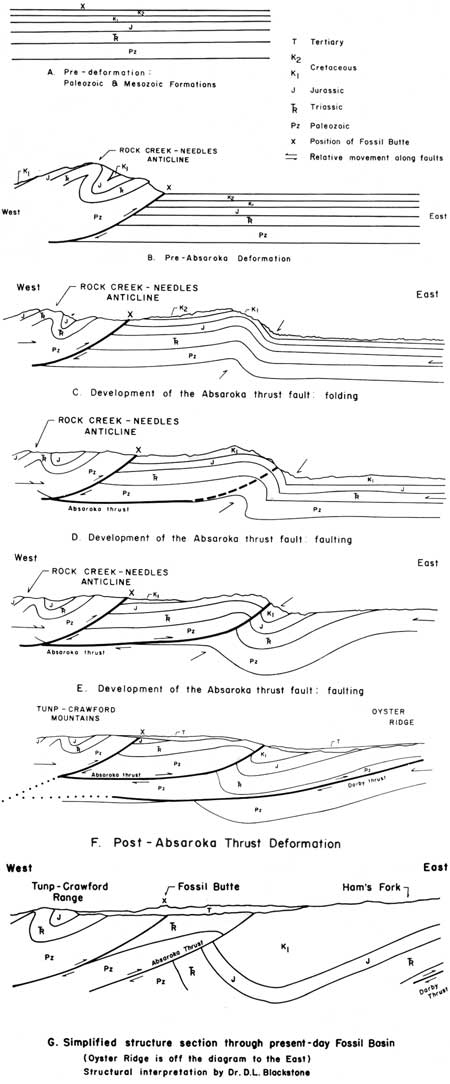|
FOSSIL BUTTE
The Geologic History of Fossil Butte National Monument and Fossil Basin NPS Occasional Paper No. 3 |

|
THE GEOLOGIC STRUCTURE OF FOSSIL BASIN
The Fossil Basin is a small, linear and structurally controlled basin in the southeastern part of the Wyoming overthrust belt. This "overthrust belt" is represented by a number of small mountain ranges and high ridges formed by the "thrusting" of sedimentary rocks over other sedimentary rocks. Topographically, the Fossil Basin is bounded by the Crawford Mountains and Tunp Range on the west, by Oyster Ridge on the east, and by the Uinta Mountains on the south. The Crawford Mountains, Tunp Range, and Oyster Ridge (Fig. 2) are areas of high relief developed upon southerly extended salient ridges of deformed Paleozoic and Mesozoic strata. In the center of the Fossil Basin, these earlier rocks are covered by a veneer of early Tertiary sediments. Superficially, the Fossil Basin appears to be a broad syncline with tilted beds dipping sharply or gently basinward from the basin margins. The Tertiary sedimentary cover, however, partially obscures what is a more complex structural history.
Following deposition of the Late Cretaceous Adaville Formation, the Fossil Basin was included in a period of intense structural deformation. This deformation was the result of compressional forces acting along a more or less east-west alignment. The strain, or the resolution of these forces, was developed along a north-south alignment or perpendicular to the compressional forces. As the stress level became too great, the rocks were first folded and then faulted. Initial faulting of the rocks relieved some of the stress; however, with continued application of compressive forces many stages of folding and faulting were generated. Because the alignment of the compressive forces remained about the same throughout deformation (i.e., east-west) and because the strongest relative compressive forces were from the west, successively younger folds and faults were generated in an eastward direction.

|
| Fig. 9. Structural development of the Fossil Butte area. (click on image for an enlargement in a new window) |
The structural evolution of the Fossil Butte area may be interpreted as follows from the schematic diagrams:
The Rock Creek-Needles Anticline is developed at the western edge of the Fossil Basin. The present topographic highs developed on this structure are the Crawford Mountains and Tunp Range (Fig. 9-B).
With continued application of compressional forces, Paleozoic and Mesozoic rocks to the east of the Rock Creek-Needles Anticline are folded (Fig. 9-C).
The fold becomes sharply asymmetrical and when the rocks can no longer accommodate the compressional forces by further folding, a low-angle fault is developed (Absaroka thrust fault). This fault probably began as a fracture parallel to bedding which rose to topographic surface at a low angle at the point of greatest strain in the fold. Most likely, this fracture was an eastward extension of the fault underlying the Rock Creek-Needles Anticline, as depicted in Fig. 9-D.
The rocks to the west of the newly developed fault overrode those to the east. This was accompanied by further downwarping in the syncline to the east of the fault and the erosion of uplifted sedimentary rocks on the west side of the fault (Fig. 9-E).
Another cycle of folding and faulting was initiated to the east of the Absaroka fault. This post-Absaroka deformation instigated further downwarping of the Fossil Basin area between the Tunp-Crawford Mountains and Oyster Ridge. Tertiary sediments began to accumulate in the Fossil Basin (Fig. 9-F).
In early Eocene times, the effects of continued downwarping allowed Fossil Lake to form in the Fossil Basin. By the late Eocene, however, basinal subsidence could no longer keep pace with deposition and the dominantly lacustrine (lake) sedimentation was replaced by a fluvia-tile (riverine) sedimentary regime. Deposition of fluvia-tile sediments probably continued into the later Tertiary when, in the late Pliocene, regional uplift of the Rocky Mountain interior reversed the sedimentary cycle from depositional to erosional. The last 3 or 4 million years of geologic history have witnessed the excavation of much of the Tertiary sedimentary fill from the Fossil Basin. Fossil Butte and the Ham's Fork Plateau to the northeast of the butte are high erosional remnants of this early Tertiary basin fill. The traces of the Absaroka and other thrust faults are buried beneath these remaining Tertiary deposits in the Fossil Basin.
While most of this complex structural history took place before the Tertiary sediments were deposited, some deformation continued into the early Eocene. Near Prow Point, for example, is a fault that developed during early Eocene time. This can be noted in the very northwest corner of the monument, just to the west of Prow Point (Fig. 6). Here, the Lower Member of the Wasatch Formation on the west is faulted against the Main Body on the east (USDI 1964). This fault also is responsible for elevating the Thaynes Limestone so it is exposed (Fig. 10).

|
| Fig. 10. Structural relation of older rocks to Wasatch and Green River formations near Prow Point in the northwest corner of the monument (from U.S. Department of the Interior 1964). |
| <<< Previous | <<< Contents >>> | Next >>> |
sec3.htm
Last Updated: 01-Mar-2005